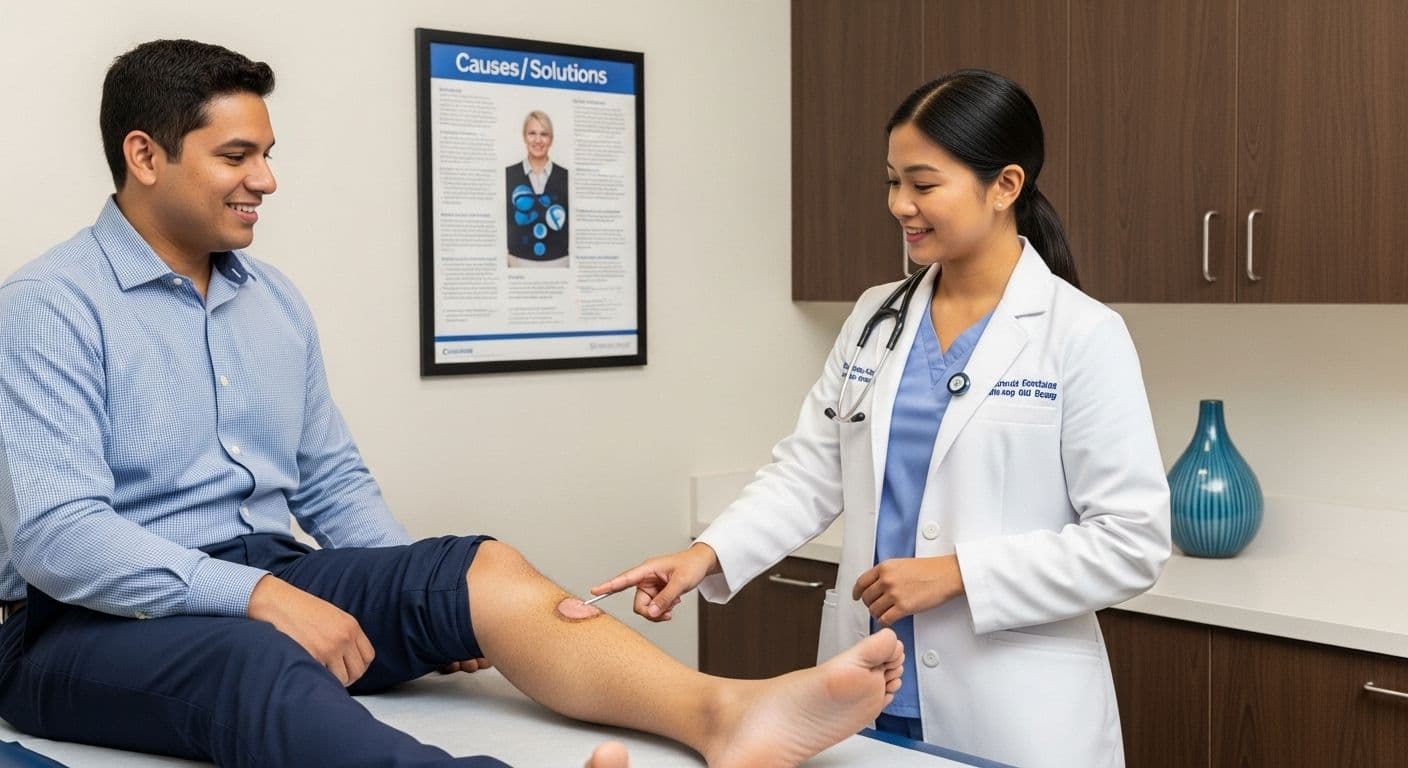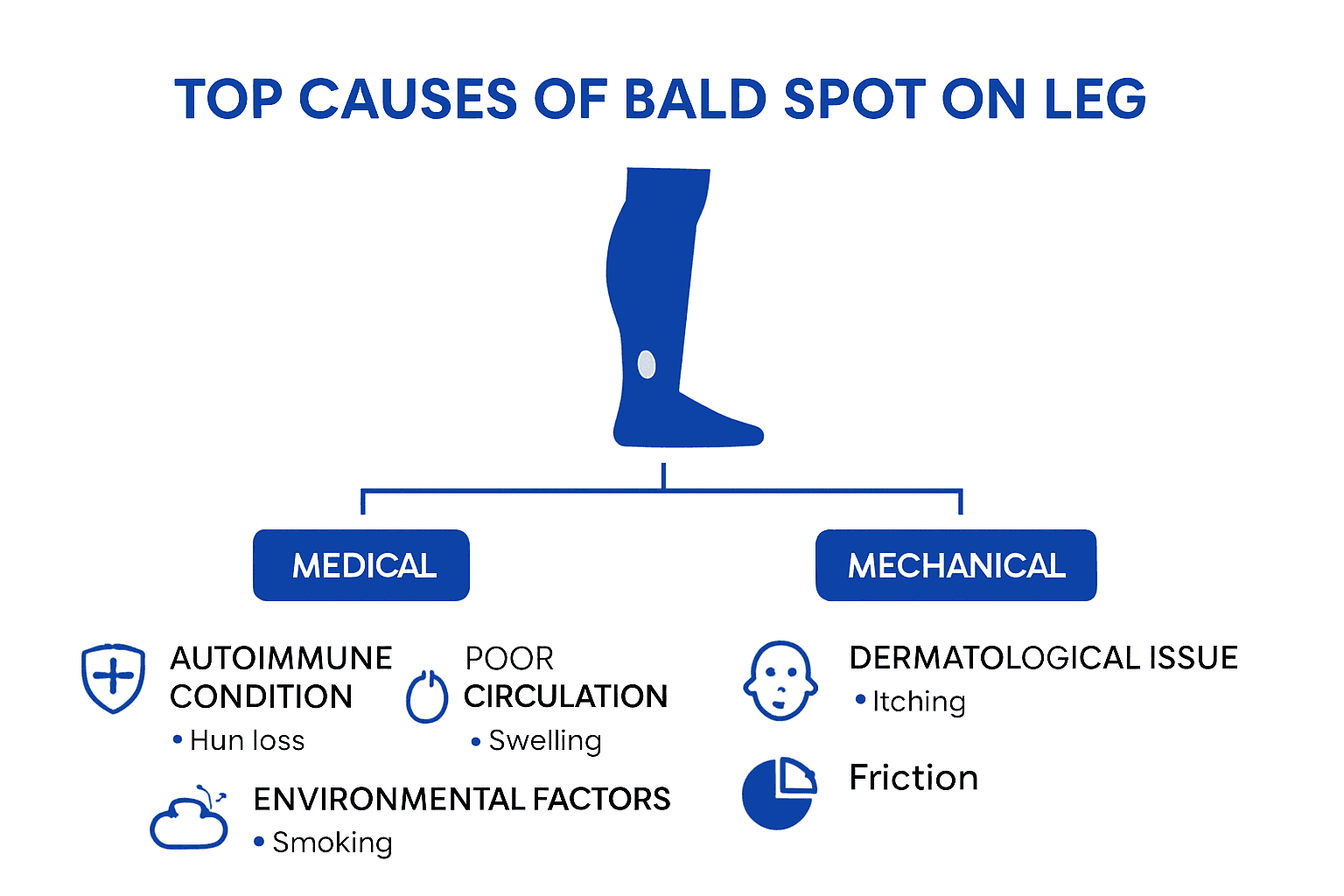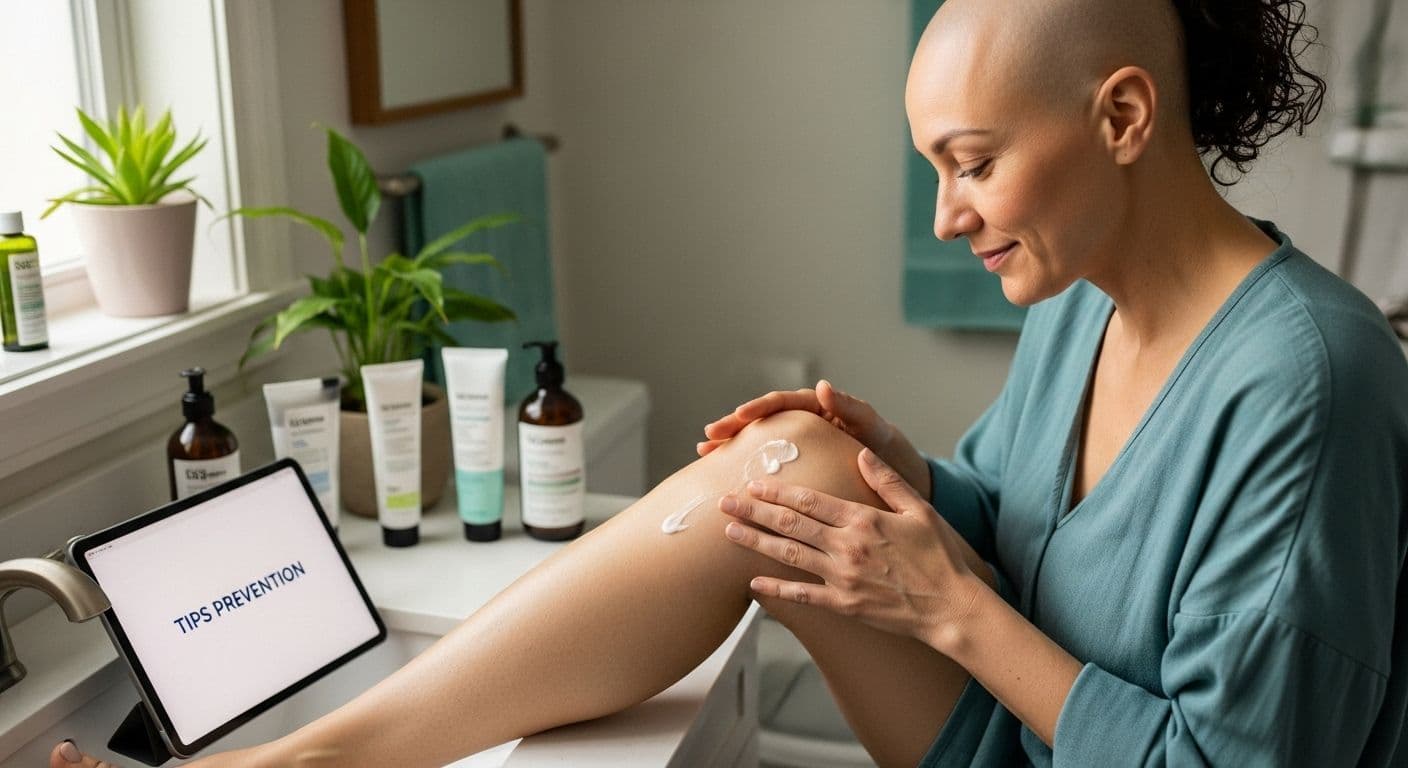Blog
Learning Materials
Bald Spot on Leg: Causes, Solutions, and Prevention
Updated: August 11, 2025

Noticing a bald spot on your leg can feel strange and even worrying. Most people expect hair loss to hit the scalp, not just pop up on a shin. Here’s something surprising though. Certain autoimmune conditions cause sudden, round leg bald spots, and these can appear without any warning. That patch of missing hair could be your body signaling something bigger than just cosmetic change.
Table of Contents
- Common Causes Of Bald Spot On Leg
- How To Diagnose And Track Hair Loss
- Best Treatments And Hair Care Solutions
- Tips To Prevent Bald Spots On Legs
Quick Summary
| Takeaway | Explanation |
|---|---|
| Identify potential health issues | Bald spots on the leg can indicate underlying health conditions that require attention. |
| Consult a healthcare professional | Seek expert advice for accurate diagnosis and tailored treatment options. |
| Adopt a nutritious diet | Include protein, iron, and essential nutrients to support hair follicle health. |
| Protect skin and follicles from damage | Use gentle products and avoid friction to maintain healthy hair growth. |
| Monitor changes regularly | Track hair growth patterns and early signs of hair loss for effective management. |
Common Causes of Bald Spot on Leg
Bald spots on the leg are not just cosmetic concerns but potential indicators of underlying health conditions. Understanding the root causes is crucial for proper diagnosis and treatment. These localized areas of hair loss can stem from various medical, environmental, and physiological factors that disrupt normal hair growth patterns.
Here's a summary table highlighting the main causes of bald spots on the leg, along with examples and typical symptoms for quick reference:
| Cause | Example Conditions | Typical Symptoms |
|---|---|---|
| Autoimmune/Dermatological | Alopecia areata, Psoriasis, | Sudden round bald patches, inflammation |
| Folliculitis, Lichen Planus | Redness, smooth skin, itchy areas | |
| Circulatory/Vascular | Peripheral vascular disease, | Hair loss with skin discoloration, |
| Diabetes, Venous insufficiency | slower healing, cool skin | |
| Mechanical/Environmental | Tight clothing, Repeated friction, | Localized hair loss at contact points, |
| Sun exposure, Chemical contact | irritation, dry or rough skin |

Autoimmune and Dermatological Triggers
Research published in the International Journal of Trichology reveals that autoimmune disorders play a significant role in leg hair loss. Conditions like alopecia areata can cause sudden, circular bald spots characterized by smooth, round patches where hair follicles are attacked by the body's immune system. These patches often appear without warning and can progress rapidly.
Other dermatological conditions contributing to leg bald spots include:
- Folliculitis: Inflammation of hair follicles causing localized hair loss
- Lichen Planus: A skin condition causing inflammatory patches
- Psoriasis: An autoimmune disorder that can disrupt hair growth
Circulatory and Vascular Factors
Poor blood circulation can significantly impact hair growth on the legs. Peripheral vascular diseases, diabetes-related circulatory issues, and chronic venous insufficiency can compromise hair follicle health. When blood flow is restricted, hair follicles struggle to receive adequate nutrients and oxygen, leading to potential hair loss in specific leg areas.
Vascular problems might manifest through additional symptoms like:
- Skin discoloration
- Reduced sensation
- Slower wound healing
- Temperature changes in the affected leg region
Mechanical and Environmental Causes
Some bald spots result from external factors rather than internal health conditions. Repeated friction from tight clothing, prolonged pressure, or frequent mechanical trauma can damage hair follicles. Athletes, individuals with physically demanding jobs, or those wearing restrictive garments might experience localized hair loss due to constant skin irritation.
Environmental factors like extreme temperature variations, prolonged sun exposure, and chemical interactions can also contribute to leg hair loss. Dermatological studies suggest that persistent skin damage can permanently impair hair follicle function.
While these causes might seem overwhelming, understanding them is the first step toward effective management. Learn more about personalized hair loss solutions that can help you address leg bald spots comprehensively.
Consult a healthcare professional for accurate diagnosis, as each bald spot tells a unique story about your body's internal health landscape.
How to Diagnose and Track Hair Loss
Diagnosing a bald spot on your leg requires a systematic and comprehensive approach that goes beyond surface-level observations. Understanding the nuanced diagnostic techniques can help you identify the underlying causes and develop an effective management strategy.
Clinical Assessment and Medical History
According to the Mayo Clinic, a thorough diagnostic process begins with a comprehensive medical history and physical examination. Healthcare professionals will explore critical factors such as family history of hair loss, recent health changes, medication usage, and potential stress factors that might contribute to localized hair loss.
Key aspects of clinical assessment include:
- Detailed examination of the bald spot's characteristics
- Assessing skin texture and inflammation
- Evaluating overall hair density and distribution
- Checking for signs of underlying skin conditions
Advanced Diagnostic Techniques
Research from the NCBI Bookshelf highlights several advanced diagnostic tools used by medical professionals to track and analyze hair loss. These techniques provide more precise insights into the nature and progression of hair loss.
Diagnostic methods include:
- Pull Test: Evaluating hair strand strength and follicle health
- Dermoscopy: Microscopic examination of hair and scalp
- Trichoscopy: Advanced imaging technique for detailed follicle analysis
- Scalp Biopsy: Definitive test to determine specific hair loss causes
Technological Tracking and Monitoring
Explore our advanced hair loss tracking solutions that leverage cutting-edge technology to monitor hair growth patterns. Modern diagnostic approaches now incorporate digital tracking methods that allow for precise measurement and documentation of hair loss progression.
Johns Hopkins Medicine emphasizes the importance of regular monitoring and professional consultation. While technology provides valuable insights, expert interpretation remains crucial in developing an accurate diagnosis and personalized treatment plan.
Remember that each bald spot is unique, and a professional assessment offers the most reliable path to understanding your specific hair loss situation. Proactive tracking and early intervention can significantly improve potential treatment outcomes and help restore hair growth.
Best Treatments and Hair Care Solutions
Addressing bald spots on the leg requires a multifaceted approach that combines medical interventions, lifestyle modifications, and targeted hair care strategies. Understanding the most effective treatments can help restore hair growth and prevent further loss.
The following table organizes the main treatment and care approaches for leg bald spots, showing their purpose and common examples for easy comparison:
| Treatment Approach | Purpose | Example(s) |
|---|---|---|
| Medical Interventions & Topicals | Reduce inflammation, stimulate growth | Corticosteroid injections, Minoxidil, Immunotherapy |
| Holistic Hair Care & Nutrition | Support follicle health, prevent loss | Balanced diet, gentle handling, micronutrients |
| Advanced Tech Interventions | Enhance regrowth, monitor progress | Laser therapy, PRP, AI-based tracking |
Medical Interventions and Topical Treatments
The American Academy of Family Physicians recommends several medical approaches for managing localized hair loss. For autoimmune-related bald spots, treatment options include:
- Corticosteroid Injections: Directly targeting inflammation in affected areas
- Topical Immunotherapy: Stimulating immune response and hair regrowth
- Minoxidil Applications: Promoting blood circulation and hair follicle activation
Intralesional corticosteroid injections prove particularly effective for patients with less than 50% scalp involvement, offering a targeted approach to addressing bald spots.
Holistic Hair Care and Nutritional Support
According to the Mayo Clinic, comprehensive hair care extends beyond medical treatments. Gentle hair management and nutritional support play crucial roles in preventing and managing hair loss:
- Protect hair from excessive sun exposure
- Use soft detangling tools
- Avoid harsh chemical treatments
- Maintain a balanced diet rich in proteins and micronutrients
- Manage stress through relaxation techniques
Advanced Technological Interventions
Learn about our innovative hair restoration techniques that combine cutting-edge technology with personalized treatment plans. Modern approaches include:
- Precision laser therapies
- Platelet-rich plasma (PRP) treatments
- Advanced follicle regeneration techniques
- AI-powered hair growth tracking and analysis
Each treatment strategy requires careful consideration of individual factors such as underlying health conditions, genetic predispositions, and specific characteristics of the bald spot. Consulting with a healthcare professional remains the most reliable path to developing a targeted and effective hair restoration plan.
Remember that patience and consistent care are key. Hair regrowth is a gradual process that demands a comprehensive and personalized approach. While some treatments show immediate results, others may require several months of dedicated management to observe significant improvements.
Tips to Prevent Bald Spots on Legs
Preventing bald spots on legs requires a proactive and holistic approach that addresses both internal health and external care practices. By understanding the underlying factors and implementing strategic interventions, individuals can significantly reduce the risk of developing localized hair loss.
Nutritional and Lifestyle Strategies
The Cleveland Clinic emphasizes the critical role of nutrition and lifestyle in maintaining healthy hair growth. A comprehensive prevention strategy should focus on several key areas:
- Consume a diet rich in protein, iron, and essential nutrients
- Manage stress through regular exercise and relaxation techniques
- Maintain consistent sleep patterns
- Avoid extreme weight fluctuations
- Stay hydrated and maintain overall metabolic health
Nutritional supplements containing biotin, zinc, and vitamin D can support hair follicle health and potentially prevent premature hair loss. Consulting with a healthcare professional can help develop a personalized nutritional plan tailored to your specific needs.
Skin and Follicle Protection
Research from the National Institute of Arthritis and Musculoskeletal and Skin Diseases highlights the importance of maintaining healthy skin microbiome and reducing inflammatory responses. Protective strategies include:
- Use gentle, non-irritating skincare products
- Avoid excessive friction from tight clothing
- Protect legs from prolonged sun exposure
- Maintain proper hygiene without over-cleansing
- Use moisturizers that support skin barrier function
Proactive Hair and Skin Management
Learn about advanced hair protection techniques that go beyond traditional care methods. Modern prevention approaches incorporate:
- Regular skin and hair health assessments
- Early intervention for any signs of inflammation
- Monitoring hormonal and metabolic changes
- Using technology to track hair growth patterns
- Implementing personalized care routines
According to the Mayo Clinic, while genetic hair loss might not be entirely preventable, many forms of hair loss can be mitigated through careful management. This includes avoiding harsh treatments, protecting skin from environmental damage, and maintaining overall health.
Remember that prevention is a continuous process. Each individual's hair loss prevention strategy will be unique, depending on genetic predisposition, overall health, and environmental factors. Patience, consistency, and a holistic approach are key to maintaining healthy leg hair and preventing unexpected bald spots.

Frequently Asked Questions
What are common causes of bald spots on the leg?
Bald spots on the leg can be caused by various factors, including autoimmune conditions like alopecia areata, dermatological issues such as psoriasis and folliculitis, circulatory problems like peripheral vascular disease, and mechanical factors such as friction from tight clothing.
How can I diagnose the bald spot on my leg?
Diagnosis typically involves a thorough medical assessment, including a detailed medical history, physical examination of the affected area, and possibly advanced diagnostic techniques like a pull test or dermoscopy to analyze hair and skin condition.
What treatments are available for bald spots on legs?
Treatment options may include medical interventions like corticosteroid injections or topical treatments, supportive nutritional strategies, and advanced technologies such as laser therapy or platelet-rich plasma (PRP) treatments, depending on the identified cause.
What steps can I take to prevent bald spots on my legs?
Preventive measures include maintaining a nutritious diet rich in essential nutrients, protecting the skin from excessive friction and sun exposure, and practicing regular skin and hair care routines to support overall follicle health.
Take Control of Leg Hair Loss With Smart, Tailored Solutions
Have you noticed a sudden bald spot on your leg and wondered what it really means for your health? If you're worried about the causes described in this article, such as autoimmune triggers or friction issues, and you want a solution designed just for you, it's time to act. The uncertainty of what's happening under your skin can be unsettling, especially when the changes appear quickly and without warning. Now you can take the guesswork out of understanding hair loss with expert guidance and continuous tracking.

Experience peace of mind with MyHair.ai, your personalized platform for AI-driven hair health analysis. Upload your scans and get immediate insights into your specific bald spots, including detailed projections and custom product suggestions. Don't wait for leg hair loss to become a bigger issue. Start tracking changes and discover the latest solutions for covering and reversing bald spots today. Take the first step toward healthier legs and renewed confidence—visit MyHair.ai now.